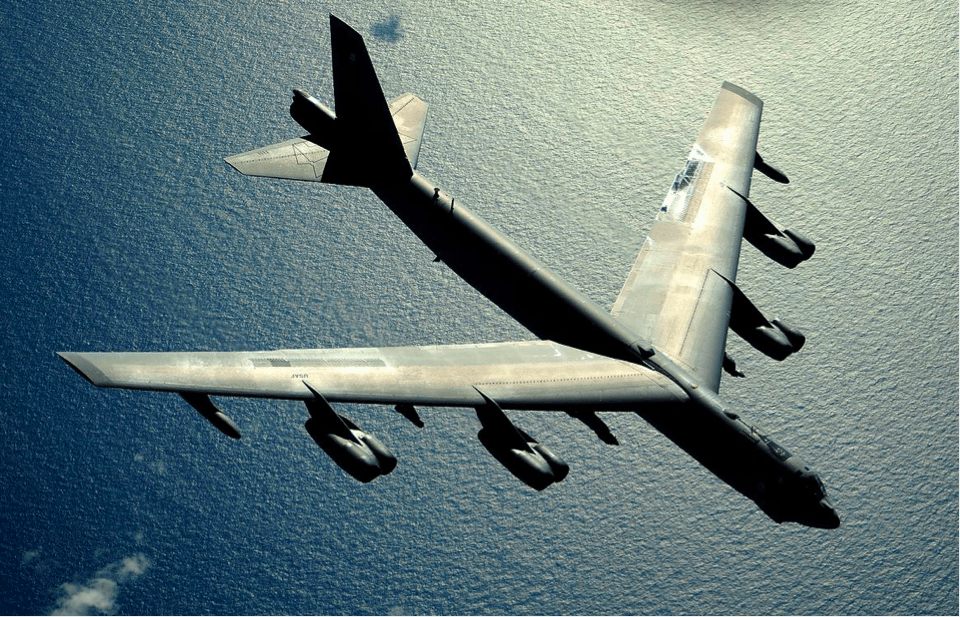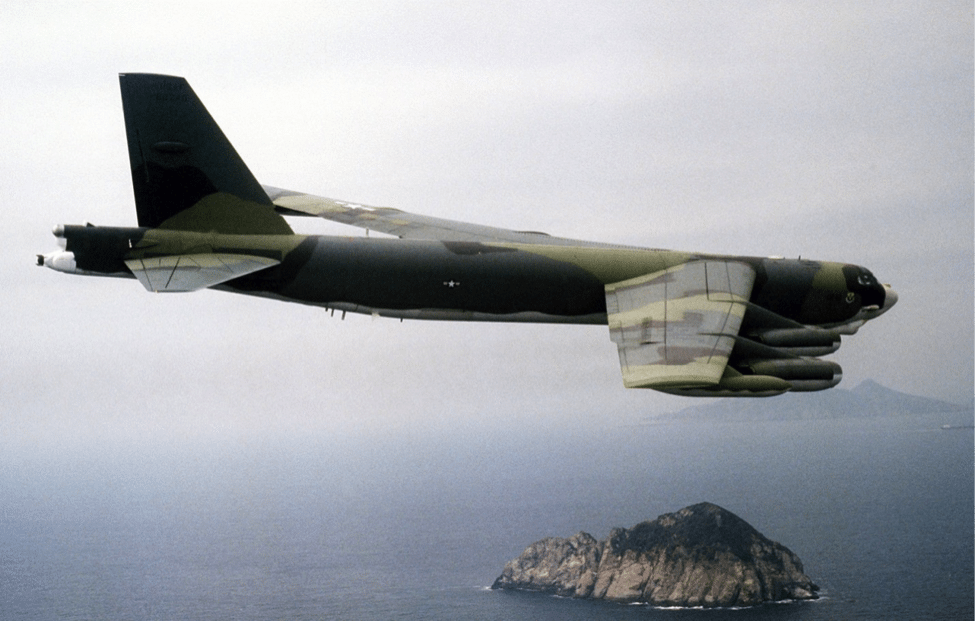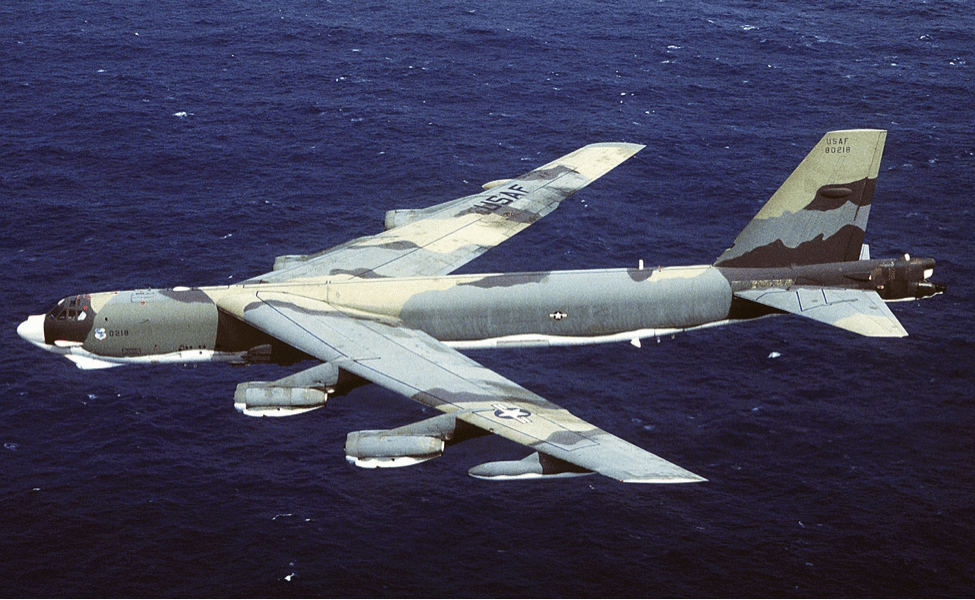Mission Critical
During the 1960s B-52s, along with their Boeing B-47 Stratojet and Convair B-58 Hustler strategic bomber brothers, performed airborne alert missions under imaginative code names like Chrome Dome, Hard Head, Round Robin, Giant Lance, and Head Start. Flying at high altitude near the borders of the Soviet Union, the bombers were there to provide rapid first strike or retaliation capability in case of nuclear war. Remember that this was the time of Mutually Assured Destruction (MAD) thinking. But when the Soviets demonstrated to the world in 1960 that their surface-to-air missiles (SAMs) were capable of bringing down aircraft at high altitude, the strategic bomber mission profile went from high in the sky to low in the weeds. The B-52 adapted. The B-47 adapted to other roles. The B-58 did not.

Bigger and Better Still
To support the change in the BUFF’s mission profile, SAC began the Big Four modification program for all operational B-52s except early B models. Also called Modification 1000, the four primary modifications to the B-52 fleet included the ability to launch the North American AGM-28 Hound Dog standoff nuclear missile and the McDonnell ADM-20 Quail decoy, an advanced electronic countermeasures (ECM) suite to improve survivability in the current battlespace, and airframe upgrades to better enable the B-52 to perform the all-weather, low-altitude interdiction mission required of the BUFFs as dictated by changing (and improving) Soviet air defense capabilities. The Big Four program was completed in 1963.

Wither the BUFF?
Also during the 1960s (after only about ten years of service) concerns were raised about the expected life span of the B-52. Already the B-58 and the North American XB-70 Valkyrie had been aborted or simply proven to be unviable solutions as replacements for the BUFF. On 19 February 1965, SAC Commander General Curtis E. LeMay told the United States Congress he was afraid that “The B-52 is going to fall apart on us before we can get a replacement for it.” LeMay, and his successors with SAC, would continue to operate B-52s as the single bomber in the arsenal with the range and payload to deliver strategic ordnance on target. In fact, the B-52 outlasted LeMay and SAC. When SAC was disbanded in 1992, BUFFs were still flying missions and getting their jobs done.

Like Nothing Else
B-52s were unique in several ways. Equipped with both upward and downward firing ejection seats, the BUFF’s emergency egress system didn’t give the radar navigator and navigator a warm fuzzy when they were at work on the lower deck. At least the other four crew positions ejected upward. Instructors riding in the other seats would have to jump on their own in an emergency egress situation. The B-52 also had the ability to “crab” into a crosswind and for taxying and takeoff up to 20 degrees off the runway heading if necessary. The aircraft was not designed for high maneuverability so it had tiny ailerons. Roll control was achieved using spoilerons instead. Later models did away with the ailerons altogether and added an additional spoileron. One very noticeable characteristic of many B-52s are the “wrinkles” in the fuselage skin forward of the wing leading edge. Some call them age wrinkles, but they’re only there on the ground. In the air the B-52 looks as young as any other 50-something year old.

Disaster Over Andalusia
On 17 January 1966, A Chrome Dome-tasked B-52G Stratofortress and a Boeing KC-135 Stratotanker collided in mid-air at 31,000 feet during mid-air refueling over Palomares in Spain. All four crew on the tanker were killed. Four of the seven crew members aboard the bomber survived. The bomber was carrying a payload of four B-28FI thermonuclear bombs when it broke up in flight. Each bomb was capable of a nominal yield of 1.45 megatons. Three of the weapons impacted the Spanish countryside and one came down in the Mediterranean Sea. One unexploded weapon was recovered more or less intact on the ground, but the conventional explosives contained in two of the weapons detonated on impact, spreading plutonium and requiring a massive cleanup of contaminated soil. The bomb that came down in the Med was eventually recovered after two and a half months.

Keeping the BUFF in the Game
Programs like Jolly Well (fixes and upgrades to the computers) in 1964, Rivet Rambler (expanded ECM capability) in 1971, and Rivet Ace (additional ECM expansion) in 1973 kept the B-52 fleet as electronically up-to-date as possible. But it was the AN/ASQ-151 electro-optical viewing system (EVS) that added the most obvious external indication of improved electronic warfare capability. EVS combined a forward-looking infrared (FLIR) system in the starboard side chin fairing and a low light level TV (LLLTV) in the port side chin fairing. Added between 1972 and 1976, this system improved the ability of the BUFF to penetrate at low altitude and hit targets effectively.


[…] loves the BUFF. Boeing’s B-52H Stratofortress is still a front line weapons system more than sixty years after it entered United States Air Force […]
I was stationed at Blytheville Air Force Base in the 70’s. I also spent two years in Guam. I refueled the BUFF and KC-135’s in both places. Everything you said was right on. the only thing I may want to say is Anderson was(in the 70’s) called Anderson Air Base (drop the word Force), as it was the only permanent SAC base outside CONUS at that time. I watched them take off and land everyday, as my job had me on the flight line every day.
Bill: Your review is one of the best I ever read. The only thing I would add is that, in total, 744 B-52’s of all models were built. I was an Air Policeman with the 379th Air Police Squadron working flightline security with the 379th Bomb Wing (Heavy) at Wurtsmith AFB, Oscoda, MI from Dec 63 to Aug 67. I love the Buff, despite freezing by butt off many a cold Michigan night guarding them. I will travel out of my way to see one in a museum. One of my biggest thrills was seeing a full on MITO with 8 B-52’s and 5 KC-135’s during an ORI exercise one year. I was at the take-off end of the runway and they peeled off right over me. I will never forget the noise, smoke and pure power of freedom.